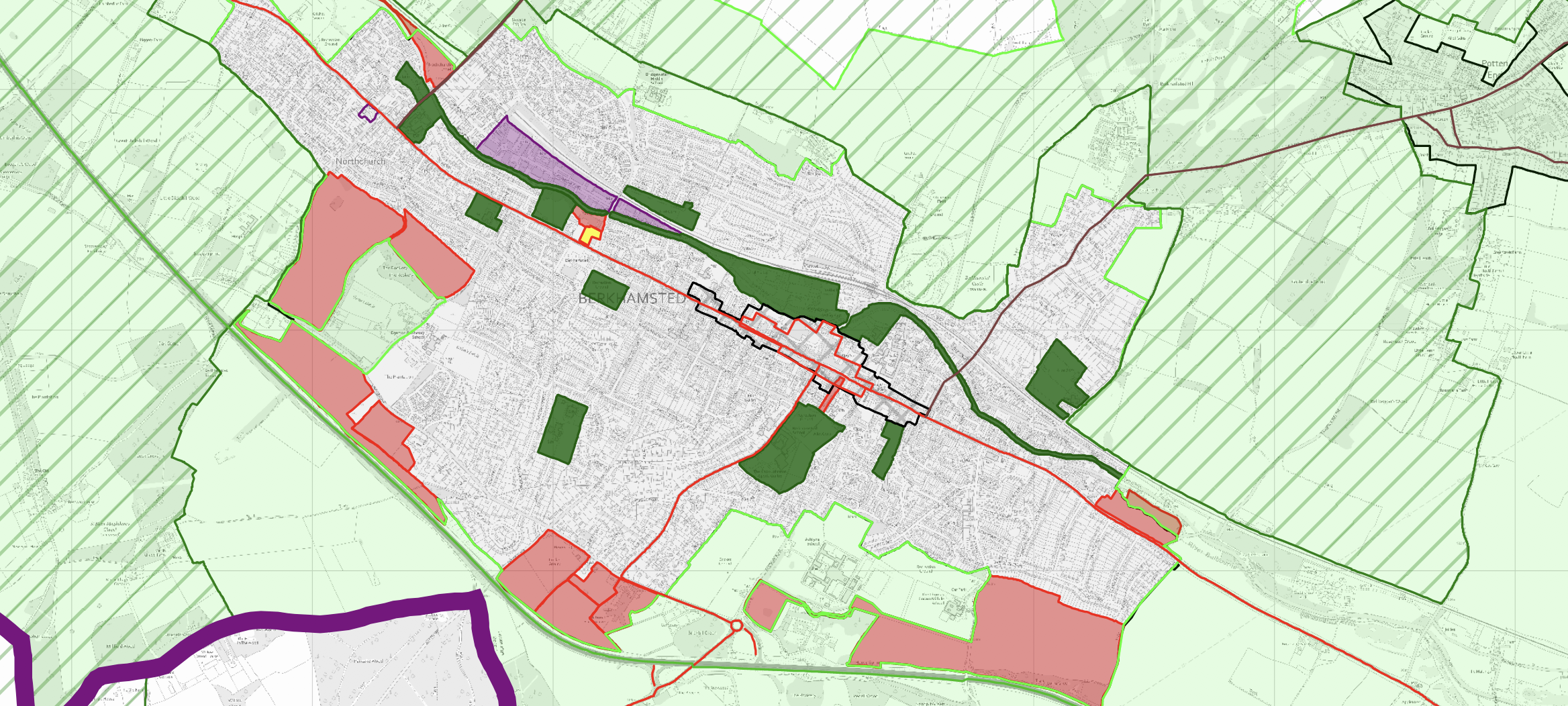
Each town in Dacorum will be affected in different ways by the Local Plan, but the impact of an unchanged plan would change our communities in fundamental ways.
Our general response to the Local Plan can be seen in a previous post.

Paul De Hoest is one of two Dacorum Green Party Town Councillors in Berkhamsted, and he made observations and comments that we included in our official response to Dacorum Borough Council:
Berkhamsted:1. Green Belt: This plan inflicts a 25% increase in housing for Northchurch and Berkhamsted: 2250 homes of which 1750 are on existing Green Belt land (78%).
Various Governments have made numerous statements in support of the protection to our precious Green Belt over the years. As recently as December 16th 2020 this Government, in a published a response to the recent white paper consultations stated, with reference to protected landscapes and Green Belt, “We should be clear that meeting housing need is never a reason to cause unacceptable harm to such places.” This draft plan makes a mockery of such statements as the growth in homes across the borough is driven entirely by a national target that bears no relation to actual local need, topography or infrastructure.
The National Planning Policy Framework (19 February 2019) (NPPF) states: “The Government attaches great importance to Green Belts. The fundamental aim of Green Belt policy is to prevent urban sprawl by keeping land permanently open; the essential characteristics of Green Belts are their openness and their permanence (Paragraph 133 NPPF).” Releasing Green Belt land on the scale envisaged in this draft plan ought to be difficult to justify since paragraph 136 of the NPPF is totally clear that: “Green Belt boundaries should only be altered where exceptional circumstances are fully evidenced and justified, through the preparation or updating of plans.” The “exceptional circumstances” that could justify release of Green Belt land on such a scale are simply not evidenced in these documents.
2. Character: the town is recognised for its charm and character. The 2013 Core Strategy affirmed the Borough’s commitment to maintaining the unique linear valley configuration of the town and recognised the importance of preserving the ridge skyline. Most of the sites chosen are on the southern ridge above Northchurch and Berkhamsted thus reneging on that commitment and creating a massive urban sprawl that fundamentally would alter the character of the town.
3. Connectivity: It is already acknowledged that the town centre is prone to excessive congestion. These new homes are predominantly sited over a mile away from the town up the steep valley sides. There seems to be no acknowledgement that the associated additional traffic flow cannot be accommodated. There is no scope for widening roads to facilitate traffic flow and the main cross roads in the centre of town is already at logjam for much of the day (outside of Covid restrictions). There are no bespoke cycle ways in Berkhamsted and the existing footpaths that could connect these sites to the central hub were constructed as narrow high sided gloomy corridors.
4. Environmental damage: the Green Belt is not just a “nice to have” or just a route for people to pass through. Important as these things are the Green Belt is also a thriving mature habitat for vegetation, animal life and water retention. Destroying this natural environment cannot be replaced by planting a few trees somewhere else. Natural habitats have evolved over centuries and cannot be manufactured anew elsewhere. The soils are a valuable source of water retention that prevents flooding down into the town but also allows the water to seep through the layers to replenish in part the aquifers upon which we rely for water.
5. Water and sewage: there are already water shortages in the area and the River Bulbourne chalk stream is now regularly prone to drying up, again destroying generations of natural habitat. The water companies can only supply the necessary water by degrading these amenities further. Until a national water network is developed so that water from plentiful areas can be moved cross country to areas of water shortage this fact alone should prevent building on this scale.
6. Employment: the plan is completely out of balance. 2250 new homes requires 4000 new jobs. Where are these jobs to be found in this plan? Almost none in Berkhamsted and in fact the Jewsons industrial estate is to be repurposed for residential housing. Despite some likely post-covid increase in home working these developments will create even greater traffic flow as people drive either to the A41 or through the centre of town to Tring, Hemel Hemstead or cross town to the station. This makes a mockery of the sustainable communities pledge in the strategy guidance documents of last year. It also guarantees further increases in CO2 emissions thus undermining the climate emergency pledges made.
7. Medical and Social Care: Despite the addition of an expected 6,000 people there are no plans to increase the already overstretched medical, dental and social care facilities.
8. Recreational provision: not only does the filling in of all this Green Belt land mean that for the existing residents pedestrian access to reach natural countryside but there is little commitment in this plan to maintaining high quality access and green corridors. There is no commitment to increased parkland provision – considered essential for child development and mental well being. There is a shortage of sports pitch provision and despite the release of Haslam Fields, currently a sports field owned by Berkhamsted School, no additional provision is provided.